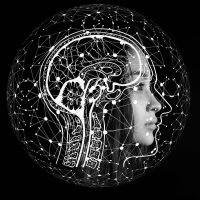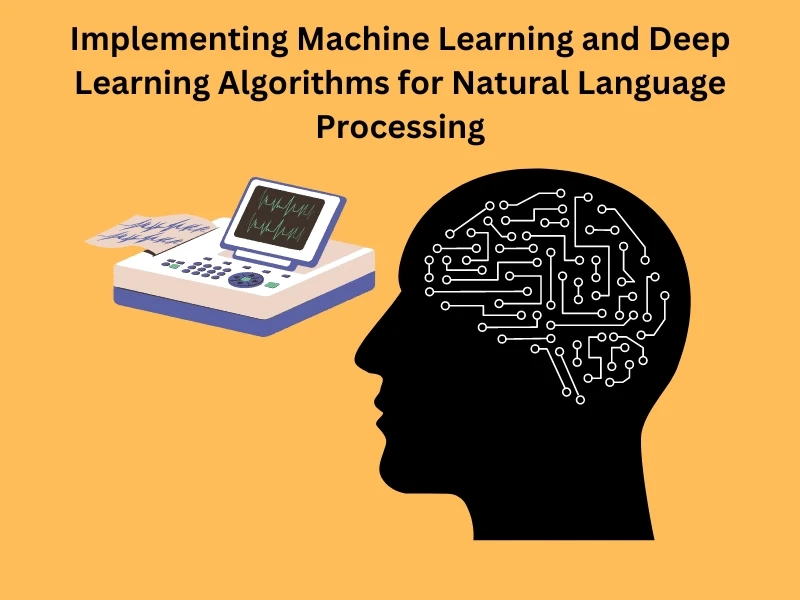Introduction to Machine Learning and Deep Learning Algorithms
Introduction to Machine Learning and Deep Learning Algorithms
If you’re looking to get into machine learning and deep learning, then you’ve come to the right place. This blog will provide an introduction to several key topics in the field of AI, helping you understand the basics of machine learning (ML) and deep learning (DL). We\'ll give an overview of ML vs. DL, supervised learning, unsupervised learning, reinforcement learning, neural networks, natural language processing (NLP), computer vision, and feature engineering. This will be a helpful guide for anyone looking to implement machine learning and deep learning algorithms for natural language processing.
Let\'s begin by introducing the concepts of ML and DL. Machine learning is a field of artificial intelligence concerned with writing algorithms that allow computers to learn from data. Rather than following fixed instructions or predetermined rules set by humans, ML algorithms are designed to improve their performance over time as they digest more information. Whereas ML algorithms can effectively handle structured data sets like images or numbers, deep learning (DL) algorithms are better suited for handling messy data sets like audio or text documents. DL algorithms are also better at recognising patterns within large data sets than traditional ML approaches can handle.
Next, we\'ll discuss supervised and unsupervised learning. Supervised learning is the process of using labeled data sets to train a model so it can accurately predict future inputs based on past patterns it\'s learned from its training. In contrast, unsupervised learning does not use any labeled training data, so its outcomes are less predictable than those of supervised models, but it can uncover hidden structures in unlabeled raw data, which is useful for clustering related items together as well as other applications such as anomaly detection or recommendation systems.
Popular ML/DL Algorithms Used in Natural Language Processing
Natural Language Processing (NLP) is an increasingly important branch of artificial intelligence that deals with understanding human language and extracting meaning from it. In order to accomplish this, many organizations are turning to machine learning (ML) and deep learning (DL) algorithms. By implementing ML and DL algorithms, they are able to extract valuable insights from vast amounts of unstructured text data.
ML and DL algorithms have revolutionized the way that NLP is tackled by allowing for a more efficient way to process data and derive useful information from sources such as articles, books, and even social media posts. The advantages of using ML or DL for NLP include increased accuracy and speed in processing large volumes of data.
One popular ML algorithm used for NLP is Naive Bayes. This algorithm works by taking in a large number of documents or text samples and then using them to generate a statistical model that can be used to classify new documents or pieces of text based on the probability of certain words appearing in them. This approach also allows you to use fewer resources while still being able to extract valuable information from your data set.
In short, implementing ML/DL algorithms for natural language processing offers a powerful way to quickly process vast amounts of data, identify patterns within it, and uncover valuable insights that can be further utilized by organizations. With the help of these algorithms, organizations are able to leverage the power of AI in order to fully utilize their data sources and gain an edge over their competition. Check out :- Data Science Training In Chennai
The NLP Problem Space
The use of machine learning (ML) and deep learning (DL) algorithms in natural language processing (NLP) has become increasingly popular in recent years, as it has been shown to be an effective way to process large amounts of natural language data. NLP involves several distinct steps and tasks, including preprocessing text data, extracting features from text data, tuning algorithms for optimal performance, evaluating models using appropriate metrics, selecting the best model for a given application, and understanding the interpretability of results. Understanding each step in this process is essential for successful implementation of ML/DL algorithms for NLP.
Preprocessing text data is the first step in implementing ML/DL algorithms for NLP. This involves transforming textual data into a form suitable for training ML and DL models. It includes cleaning up any noisy text data and converting it into a numerical or categorical format that can be used by ML and DL algorithms. Some common preprocessing tasks include removing punctuation marks, tokenizing, stemming or lemmatizing, and removing stop words.
Once your textual data is preprocessed and ready to go, you can begin feature extraction and representation. This involves extracting meaningful information from raw textual data by combining individual words or phrases into more meaningful representations such as vectors or other forms of representation specific to your application. Depending on the type of problem you are solving, certain approaches may work better than others. Popular feature extraction techniques include bagging of words, ngrams, word embeddings (word2vec), sentiment analysis (Vader sentiment analysis), and part-of-speech tagging.
How to Implement ML and DL Technical Solutions in NLP
Natural Language Processing (NLP) is a complex field of Artificial Intelligence (AI) with many applications. Implementing machine learning (ML) and deep learning (DL) algorithms for NLP tasks is an important step to unlocking their potential. This blog post will discuss how to implement ML and DL technical solutions for NLP, including data acquisition, feature engineering, model selection, hyperparameter tuning, model evaluation, and optimisation strategies.
To begin, it is important to acquire the right data for your ML and DL models. NLP models often need large amounts of data to be accurate. You can use public datasets or create your own labeled dataset using web scraping techniques and text annotation tools like Snorkel AI or Label Studio. Once you have gathered the necessary data, it\'s time to move on to feature engineering. With feature engineering, you can create different features from the raw text that will be used by ML and DL algorithms to classify text into different categories or extract information from them. Common techniques include word embeddings such as GloVe or Word2Vec, part-of-speech tagging with spaCy or NLTK, and sentiment analysis with VADER or TextBlob.
After feature engineering comes model selection and hyperparameter tuning. For ML algorithms such as Support Vector Machines (SVMs) and Random Forests, model selection involves choosing the right algorithm for the task at hand based on parameter settings like kernel type, penalty parameter, or number of trees in a forest. For DL models like deep neural networks (DNNs), the main focus is on hyperparameter tuning, finding the optimal parameters such as learning rate, batch size, and number of layers through trial and error.
Challenges Faced When Applying ML and DL Techniques for Natural Language Processing
The use of machine learning (ML) and deep learning (DL) algorithms to process natural language is becoming increasingly popular as a way of making sense of the vast amounts of textual data available online. However, applying ML and DL techniques to natural language processing (NLP) comes with its own set of challenges.
The first challenge when implementing ML and DL algorithms for NLP is the availability of data. In order to get the most accurate results from these algorithms, you need plenty of text data to work with. This can be difficult to find; if you want the data to accurately reflect real-world usage, it needs to come from natural sources such as books or articles rather than datasets that have been artificially generated. Related topic :- Data Science Institute In Delhi
Another challenge is that the algorithms used for NLP are often quite complex and require significant resources in terms of computing power and storage capacity; if your system isn\'t up to scratch, then your results will suffer. For this reason, it\'s important that you have access to good-quality hardware on which you can run the algorithms.
A third challenge is understanding the different types of language that are used in natural sources such as books or articles; writing styles vary greatly, and some algorithms may struggle to make sense of certain kinds of text. It\'s therefore important that you understand the type of text you\'re working with; familiarizing yourself with different writing styles can help ensure that your models don\'t misinterpret elements such as slang or colloquialisms.
Finally, it\'s also important to remember that NLP tasks require significant time and resources, meaning they tend not to be suitable for quick turnaround solutions; instead, they should be seen as longer-term projects that require ongoing effort in order to be successful.
Future Directions for Applying ML and DL Techniques to NLP
Implementing machine learning and deep learning algorithms for natural language processing (NLP) is a rapidly evolving field with a wide variety of potential applications. In this blog, we will discuss some of the key areas where ML and DL techniques can be applied to enhance NLP tasks.
One of the most popular applications is sequence tagging, which involves labeling each word in a sentence with its corresponding part of speech tag. This task can be tackled with various ML/DL approaches such as recurrent neural networks (RNNs) and long short-term memory (LSTM) networks. The use of these models provides improved accuracy when compared to traditional methods and has already been used in many NLP applications, such as speech recognition and text classification.
Question-answering systems are another important area for applying ML and DL techniques to NLP tasks. The use of neural networks allows us to build models that can learn from input data and derive answers from natural language questions. Such models are increasingly being used in chatbots, virtual assistants, and other automated systems.
Natural Language Generation (NLG) is another area where ML and DL techniques are being applied to create more natural-sounding results than traditional methods could achieve. With NLG, it is possible to generate text that follows certain rules but still appears natural to humans. This technique can be used for summarizing articles, generating stories based on given data, or automatically creating personalized emails or reports based on specific data points.
Sentiment analysis is another application that involves leveraging ML and DL algorithms to detect emotions from text or audio inputs such as tweets or conversations. These models can be trained on large datasets containing labeled samples, so they can learn how to differentiate between positive and negative sentiments.
Final Thoughts on Implementing Machine Learning and Deep Learning Algorithms for Natural Language Processing
The recent advancements in machine learning (ML) and deep learning (DL) algorithms have enabled natural language processing (NLP) techniques to be applied more effectively across multiple application areas. ML and DL algorithms for NLP tasks can be used to extract insights from text data, interpret user queries, and generate natural language output.
When it comes to implementing ML and DL algorithms for NLP purposes, there are several key considerations to make. First, it is important to have an appropriate training dataset that sufficiently covers the task at hand; this could include existing language datasets or can be generated by curating your own collection of tagged text. Additionally, evaluation metrics such as accuracy, precision, and recall should be monitored in order to determine how well the model performs on unseen input or data.
Furthermore, when building a system architecture to use ML and DL algorithms for NLP tasks, it can be helpful to consider what system components will best support your architecture’s needs. Furthermore, tuning hyperparameters and deploying optimisation strategies will be integral parts of the process in order to identify the most optimal model for a given application area.
In summary, when implementing ML and DL algorithms for Natural Language Processing tasks, there are many considerations that need to take place in order to ensure successful model deployment: from dataset curation and evaluation metrics monitoring to system component design, hyperparameter tuning, and optimisation strategy deployment, up until applying proper integration models into product features or services depending on specific application areas.



